#Microsoft Graph
Explore tagged Tumblr posts
Text
[General Availability] Microsoft Graph Rich Notifications
Microsoft Graph allows apps to subscribe to and receive change notifications for resources through different delivery channels. You can set up subscriptions to include the changed resource data (such as the content of a Microsoft Teams chat message or Microsoft Teams presence information) in change notifications. Change notifications that include the resource change data are called Rich…
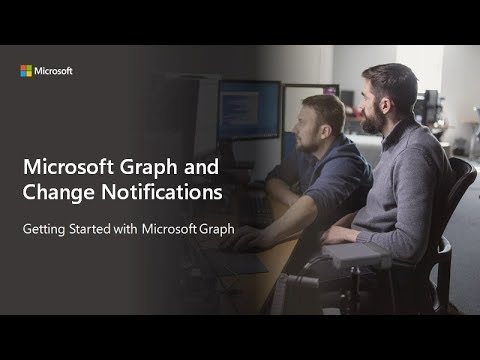
View On WordPress
#API#Change notification#chat#Developer#development#DevMSGTeam#General Availability#Graph API#Microsoft Graph#Microsoft Teams#Notification#presence#resource data#Rich Notification
0 notes
Text
Morgen ist es so weit: Microsoft 365 Copilot für Unternehmenskunden
Am 01.11.2023 wird Microsoft 365 Copilot offiziell für Unternehmenskunden verfügbar.
Am 01.11.2023 wird Microsoft Copilot offiziell für Unternehmenskunden verfügbar sein. Was das bedeutet und wie man sich, auch wenn man noch keine Copilot Lizenzen hat, auf das Thema vorbereiten kann, erfahren Sie hier. Einleitung Die Einführung neuer Technologien in einer Organisation erfordert sorgfältige Planung und Vorbereitung. Microsoft 365 Copilot ist ein solches Produkt, das Unternehmen…
View On WordPress
#Add-On#Compliance#Datensicherheit#Einführung#Lizenzierung#Microsoft 365 Copilot#Microsoft 365 E3/E5#Microsoft Graph#Office Apps#Teams#technische Anforderungen#Unternehmenskunden#Vorbereitung
0 notes
Text
What to expect from the zine
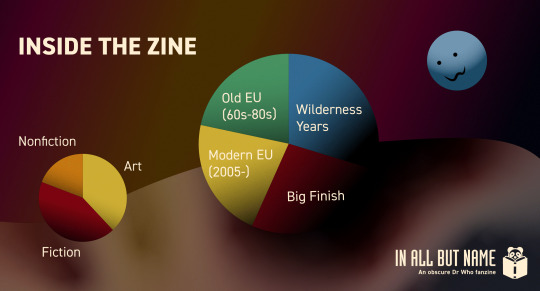
Hey everybody! For the past 3 months we've been busy bees!
For anyone wondering what to expect from our obscure Dr Who fanzine here are some statistics! We're a team of over 30 artists and writers creating for our favourite little niches of the extended universe.
Across the four categories of Big Finish, (other) Modern EU, Wilderness Years and the EU pre-cancellation, we have a pretty good balance. Hopefully every one of you obscure Who nerds will have something to look forward to!
Do you have questions? Feel free to ask away in our inbox and read the info page (link in bio)
Detailed description of the graphs under the cut
A small chart splits into three parts. about 45% are allocated to "art", another 45% to "fiction" and the remaining 10% to "non-fiction"
The second graph is split into the four categories mentioned above. All are about the same size.
#i like how this screams microsoft powerpoint graphs#fanzine#doctor who#doctor who eu#big finish#doctor who fanzine#dweu#iris wildthyme#obverse books#faction paradox#magic bullet productions
56 notes
·
View notes
Text

Microsoft Office 97 - Graph (16x16)
90 notes
·
View notes
Text
because why not, i decided to graph my boop data. so anyways, here's an intentionally hard to read graph of who booped me the most
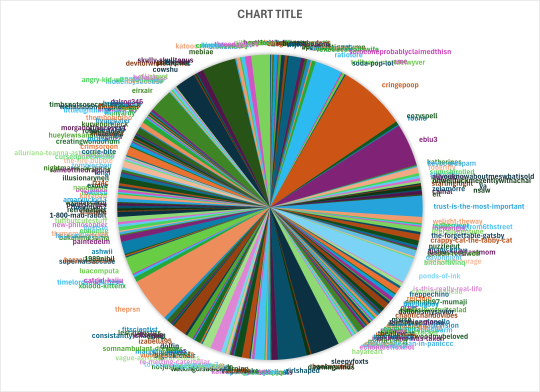
here's the top 10:
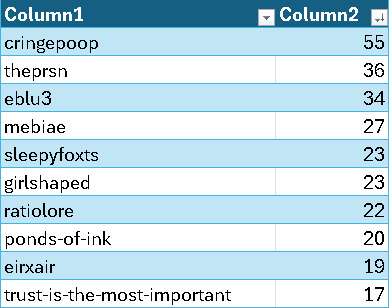
so yeah, that was fun i guess
#sometimes you have to realize you are your own biggest fan#boop#boop o meter#tumblr#excel#microsoft excel#spreadsheet#graph#chart#pie chart
13 notes
·
View notes
Text
Formatting images in a Word doc makes me want to hemorrhage.
#screaming crying throwing up#just let me move my graphs and make the text and everything below it move with it#there are probably 40 graphs and images in this doc#nightmare fuel#microsoft word#lost at work
2 notes
·
View notes
Text
got bored made a graph. topic: guys I chew on like glass and their relation to murder

#i’m normal good at using microsoft paint#and i’m extra normal good at making graphs. as you can see#excluded the two actual murders kristoph completed successfully because they aren’t as funny#realizing that another graph i could strugglingly put together is these guys and having siblings. i’ll think on it
10 notes
·
View notes
Text
Do people actually like Excel? Is it really as bad as it seems to me or is it just horribly equiped for the task of managing and analyzing the quantities of data required in science?
#its so bad#one time it ate my graphs and i told my prifessor about it#you know what he said? 'yep. that's excel.'#he's biased in favor of r i think. but still.#hylian rambles#microsoft excel
7 notes
·
View notes
Text
every time i try to put a god damned legend on this graph with seven lines on it my laptop literally freezes for minutes at a time so i can only click one thing before it goes non-responsive again. which is pretty much a great summary of how this stupid capstone project is going.
#i hate microsoft excel so much#science side of tumblr help me. i’m graphing UV spectra. i need several spectra on one graph. my python is not working for some reason#i mean it won’t open a new notebook. otherwise i would use matplotlib#i don’t know anything else. is there any software i can use#i’m sorry i’m very young and stupid i don’t know why i’m going for a phd either
5 notes
·
View notes
Text
I have given up ✨
#this professor is probably like wtf is wrong with this student she always does the assignments last minute#and she can’t even do them right half the time 💀 it’s almost as if she has no clue what’s going on or how to use Microsoft excel#yeah I know maam 😔 I could’ve been thriving in a social science rn rip#I am not built to make graphs out of water data and contour watersheds I’m just not 😭#my posts
5 notes
·
View notes
Text
How to apply patterns and color to a chart in Microsoft Word
Learn how to make charts accessible in Microsoft Word and PowerPoint. Ensure inclusivity in your documents by following these steps. #Accessibility #Charts #MicrosoftWord #PowerPoint #InclusiveDesign
In today’s blog post, we’ll dive into the crucial topic of making charts accessible in Microsoft Word and PowerPoint, a skill that is paramount for creating inclusive documents. Video Guide To begin, open your document in Microsoft Word or PowerPoint and insert the chart you want to make accessible. Get accessible documents now Ensuring Accessibility for Your Charts and Graphs The…
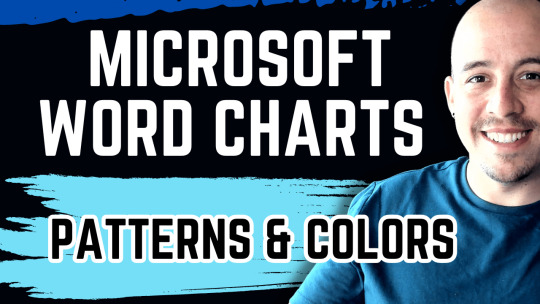
View On WordPress
0 notes
Text
Nightwing Cover Cross Stitch
I made a cross stitch pattern based on the cover of Nightwing #78 art by Bruno Redondo.

It's a full coverage piece, but you could skip the pale blue background if you wanted. It's a large piece, 200 by 307 stitches. How large yours will be will depend on what size stitches you do. If you do 11 count (11 stitches per inch) it will be 18.2 x 28 inches. If you do 26 count, it would be 7.7 x 12 inches. Always add about 5 inches to both measurements so you have plenty of space around your piece. You don't want the fabric to unravel and ruin your project. You can cut the fabric down after you're done if you don't like having a lot of excess.
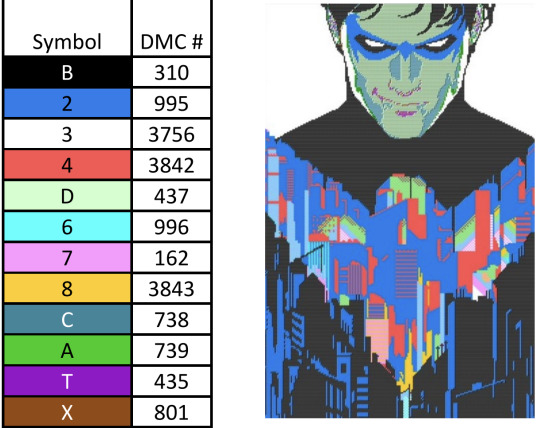
The threads I use are all in DMC, the numbers from most used to least used are 310, 995, 3756, 3842, 437, 996, 162, 3843, 738, 739, 435, and 801. Estimates for how many skeins you need are listed on both the PDF and in the excel file.
Here's the PDF file, it's printable with a chart broken up into 20 pages. (Yes, it's huge!)
And here is the Excel file, since I built it in Excel. If the colors and symbols I picked out don't work for you for whatever reason, you can edit them in excel. My instructions inside it are meant for working with it inside Microsoft Excel, I have no idea how to use google sheets so I can't help you there. You can download the file from this link and then open it up in Excel.
Also, in the excel file, I have four workbooks. The first is the chart with a grid, broken into the 20 panels I used to make the PDF. The second is the high contrast chart without a grid, the third is the graph in the colors of the suggested thread, and the fourth is all the thread information.
If anyone ends up making this, I would LOVE to see process pictures! I started mine yesterday, and I'm so excited about it. This is the first time I've ever sat down and written up one of my patterns to share, so I hope everything is easy to follow. Let me know if you have any questions!
350 notes
·
View notes
Text
It’s been twenty years since my Microsoft DRM talk
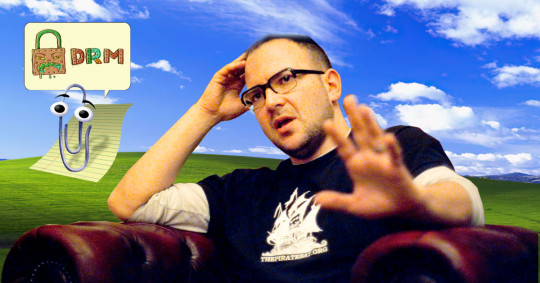
On THURSDAY (June 20) I'm live onstage in LOS ANGELES for a recording of the GO FACT YOURSELF podcast. On FRIDAY (June 21) I'm doing an ONLINE READING for the LOCUS AWARDS at 16hPT. On SATURDAY (June 22) I'll be in OAKLAND, CA for a panel and a keynote at the LOCUS AWARDS.

This week on my podcast,This week on my podcast, I read my June 17, 2004 Microsoft Research speech about DRM, a talk that went viral two decades ago, and reassess its legacy:
https://craphound.com/msftdrm.txt
It's been 20 years (and one day) since I gave that talk. It wasn't my first talk like that, but at the time, it was the most successful talk I'd ever given. I was still learning how to deliver a talk at the time, tinkering with different prose and delivery styles (to my eye, there's a lot of Bruce Sterling in that one, something that's still true today).
I learned to give talks by attending sf conventions and watching keynotes and panel presentations and taking mental notes. I was especially impressed with the oratory style of Harlan Ellison, whom I heard speak on numerous occasions, and by Judith Merril, who was a wonderful mentor to me and many other writers:
https://locusmag.com/2021/09/cory-doctorow-breaking-in/
I was also influenced by the speakers I'd heard at the many political rallies I'd attended and helped organize; from the speakers at the annual Labour Day parade to the anti-nuclear proliferation and pro-abortion rights marches I was very involved with. I also have vivid memories of the speeches that Helen Caldicott gave in Toronto when I was growing up, where I volunteered as an usher:
https://www.helencaldicott.com/
When I helped found a dotcom startup in the late 1990s, my partners and I decided that I'd do the onstage talking; we paid for a couple hours of speaker training from an expensive consultant in San Francisco. The only thing I remember from that session was the advice to look into the audience as much as possible, rather than reading from notes with my head down. Good advice, but kinda obvious.
The impetus for that training was my onstage presentation at the first O'Reilly P2P conference in 2001. I don't quite remember what I said there, but I remember that it made an impression on Tim O'Reilly, which meant a lot to me then (and now):
https://www.oreilly.com/pub/pr/844
I don't remember who invited me to give the talk at Microsoft Research that day, but I think it was probably Marc Smith, who was researching social media at the time by data-mining Usenet archives to understand social graphs. I think I timed the gig so that I could kill three birds with one stone: in addition to that talk, I attended (and maybe spoke at?) that year's Computers, Freedom and Privacy conference, and attended an early preview of the soon-to-launch Sci Fi Museum (now the Museum of Pop Culture). I got to meet Nichelle Nichols (and promptly embarrassed myself by getting tongue-tied and telling her how much I loved the vocals she did on her recording of the Star Wars theme, something I'm still hot around the ears over, though she was a pro and gently corrected me, "I think you mean Star *Trek"):
https://music.youtube.com/watch?v=4IiJUQSsxNw&list=OLAK5uy_lHUn58fbpceC3PrK2Xu9smBNBjR_-mAHQ
But the start of that trip was the talk at Microsoft Research; I'd been on the Microsoft campus before. That startup I did? Microsoft tried to buy us, which prompted our asshole VCs to cram the founders and steal our equity, which created so much acrimony that the Microsoft deal fell through. I was pretty bitter at the time, but in retrospect, I really dodged a bullet – for one thing, the deal involved my going to work for Microsoft as a DRM evangelist. I mean, talk about the road not taken!
This was my first time back at Microsoft as an EFF employee. There was some pre-show meet-and-greet-type stuff, and then I was shown into a packed conference room where I gave my talk and had a lively (and generally friendly) Q&A. MSR was – and is – the woolier side of Microsoft, where all kinds of interesting people did all kinds of great research.
Indeed, almost every Microsoft employee I've ever met was a good and talented person doing the best work they could. The fact that Microsoft produces such a consistent stream of garbage products and crooked business practices is an important testament to the way that a rotten organization can be so much less than the sum of its parts.
I'm a fully paid up subscriber to Ronald Coase's "Theory of the Firm" (not so much his other views):
https://en.wikipedia.org/wiki/Theory_of_the_firm
Coase says the reason institutions exist is to enable people to work together with lowered "coordination costs." In other words, if you and I are going to knit a sweater together, we're going to need to figure out how to make sure that we're not both making the left sleeve. Creating an institution – the Mafia, the Catholic Church, Microsoft, a company, a co-op, a committee that puts on a regional science fiction con – is all about minimizing those costs.
As Yochai Benkler pointed out in 2002, the coolest and most transformative thing about the internet is that it let us do more complex collective work with smaller and less structured institutions:
https://www.benkler.org/CoasesPenguin.PDF
That was the initial prompt for my novel Walkaway, which asked, "What if we could build luxury hotels and even space programs with the kind of (relatively) lightweight institutional overheads associated with Wikipedia and the Linux kernel?"
https://crookedtimber.org/2017/05/10/coases-spectre/
So the structure of institutions is really important. At the same time, I'm skeptical of the idea that there are "good companies" and "bad companies." Small businesses, family businesses, and other firms that aren't exposed to the finance sector can reflect their leaders' personalities, but it's a huge mistake to ascribe personalities to the companies themselves.
That's how you get foolish ideas like "Apple is a good company because they embrace paid service and Google is a bad company because they make money from surveillance." Apple will spy on you, too, if they can:
https://pluralistic.net/2022/11/14/luxury-surveillance/#liar-liar
Disney and Fox weren't Romeo and Juliet, star-crossed lovers making goo-goo eyes at each other across the table at MPA meetings. They were two giant public companies, and any differences between them were irrelevancies and marketing myths:
https://locusmag.com/2021/07/cory-doctorow-tech-monopolies-and-the-insufficient-necessity-of-interoperability/
I think senior management's personalities do matter (see, for example, the destruction of Boeing after it was colonized by sociopaths from McDonnell Douglas), but the influence of those personalities is much less important than the constraints that competition and regulation impose on companies. In other words, an asshole can run a company that delivers good products at fair prices under ethical conditions – provided that failing to do so will cost more in lost business and fines than they stand to make by cheating:
https://pluralistic.net/2024/05/24/record-scratch/#autoenshittification
Microsoft is a company founded and run by colossal assholes. Bill Gates is a monster and he surrounded himself with monsters, and they hired monsters to fill out the courts of their corporate palaces:
https://pluralistic.net/2024/06/14/patch-tuesday/#fool-me-twice-we-dont-get-fooled-again
To the extent that good things come out of Microsoft – some of its games products, the odd piece of hardware, important papers from MSR – it's in spite of the leadership; it's the result of constraints imposed by competition and regulation – and that's why Microsoft pursued such an aggressive program of extinguishing its competitors and capturing its regulators.
In retrospect, I think one of my goals in that talk was to convince those people doing good work for a rotten institution to go elsewhere and do other things. Certainly, that's one of the goals I pursue in the talks I give today. At the time, some of Microsoft's highest-profile technologists were publicly resigning over the company's war on free/open source software, so it wasn't an unrealistic goal:
https://web.archive.org/web/20030214215639/http://synthesist.net/writing/onleavingms.html
What I did not expect what that publishing the talk on my site and blogging it on Boing Boing would spark a wave of public interest that would get its message in front of several orders of magnitude more people than I spoke to at Microsoft that day. Partly, that was because I released the talk into the public domain, using the brand-new Creative Commons Public Domain Declaration (which was later replaced with the CC0 mark, due to legal issues withBu its drafting):
https://web.archive.org/web/20100223035835/http://creativecommons.org/licenses/publicdomain/
Some mix of the content of the speech, the spirit of the moment, and the novelty of that wide open license sparked a ton of interest. Jason Kottke recorded an audio version that Andy Baio hosted:
https://kottke.org/04/06/cory-drm-talk
My brutalist ASCII transcript was quickly converted to beautiful HTML by Matt Haughey and Anil Dash:
https://web.archive.org/web/20040622235333/http://www.dashes.com/anil/stuff/doctorow-drm-ms.html
For people who needed a hardcopy, there was Patrick Berry's printer-friendly stylesheet:
https://patandkat.com/pat/weblog/mirror/cory-drm/doctorow-drm-ms.html
Multiple people recorded (and sold!) audio versions, and then there were all the fan translations, into Danish, French, Finnish, German, Hebrew, Hungarian, Italian, Japanese, Norwegian, Polish, Portuguese (both EU and Brazilian), Spanish and Swedish. I stayed in touch with some of those translators, and they helped me translate the position papers I wrote for UN WIPO meetings. Those papers were so effective that ratfuckers from the copyright lobby started to steal them and hide them in the UN toilets (!):
https://web.archive.org/web/20041119132831/https://www.eff.org/deeplinks/archives/002117.php
Re-reading the speech for my podcast on Sunday, I expected to be struck by the anachronisms in it, and there were a few of those to be sure. But far more clear was the common thread running from this talk to other talks I gave that took on a significant life of their own, like my 2011 "War On General Purpose Computing" talk for CCC:
https://memex.craphound.com/2012/01/10/lockdown-the-coming-war-on-general-purpose-computing/
And my work on Adversarial Interoperability:
https://www.eff.org/deeplinks/2019/10/adversarial-interoperability
And my most recent work, on enshittification:
https://pluralistic.net/2023/08/27/an-audacious-plan-to-halt-the-internets-enshittification-and-throw-it-into-reverse/
In other words, I've been saying the same thing – in different ways – for more than 20 years. That could be depressing, but I actually found it uplifting. Two decades ago, I was radicalized by a fear that the internet would be seized by corporations and governments and transformed into a system of surveillance and control. I found my way into a job at EFF, where I worked with colleagues across multiple disciplines – coders, lawyers and activists – to fight this force.
At the time, this was a fringe cause. Most of the traditional activists I'd come up with in the feminist, antiwar, antiracist, environmental and labour movement viewed digital rights as a distraction and dismissed its partisans as sad, self-obsessed nerds who mistook fights over the management of Star Trek message boards for civil rights struggles:
https://www.newyorker.com/magazine/2010/10/04/small-change-malcolm-gladwell
I thought I was right then, and I think history has borne me out. The point of waging these fights – both in the wide public sphere and within political movements – is to get people activated before it's too late. Every day that goes by is a day when the internet becomes more inhospitable to political organizing for a better world – more surveillant, more controlling. I believed then – and believe today – that the internet isn't more important that the other fights I waged as a young activist, but I think that the internet is fundamental to those fights.
Saving the planet, smashing patriarchy, overthrowing tyranny and freeing labor are all fights that will be coordinated – Coase style – on the internet. Without a free, fair and open internet, those fights are infinitely harder to win.
The project of getting people to understand, care about, and fight for digital rights is a marathon, not a sprint. When I joined EFF, it was already 12 years old. There were six people in the org then (I was the seventh). Today, there's more than a hundred of us, and we're stretched so thin! The 30+ year old idea that internet policy will intersect with every part of every fight has been utterly vindicated.
Back in 2004, I asked Microsoft why they were willing to fight the US government to the death over antitrust enforcement, but were such wimps when confronted with the entertainment industry's demands for DRM. 20 years later, I think I know the answer: Microsoft understood that DRM would let them usurp the relationship between creative workers, entertainment industry companies, and audiences. Their perfect instincts for seeking out and capitalizing on opportunities to seize monopoly power drove them to make deliberately defective products, in the belief that their market power would let them cram those products down our throats:
https://memex.craphound.com/2004/01/27/protect-your-investment-buy-open/
Here's a link to the podcast episode:
https://craphound.com/news/2024/06/16/my-2004-microsoft-drm-talk/
And here's direct link to the MP3 (hosting courtesy of the Internet Archive; they'll host your stuff for free forever):
https://archive.org/download/Cory_Doctorow_Podcast_470/Cory_Doctorow_Podcast_470_-_My_2004_Microsoft_DRM_Talk.mp3
And here's the RSS feed for my podcast:
https://feeds.feedburner.com/doctorow_podcast

If you'd like an essay-formatted version of this post to read or share, here's a link to it on pluralistic.net, my surveillance-free, ad-free, tracker-free blog:
https://pluralistic.net/2024/06/18/greetings-fellow-pirates/#arrrrrrrrrr
#pluralistic#drm#enshittification#microsoft#microsoft research#podcasts#mp3s#history#trusted computing#ngscb#retrospectives
284 notes
·
View notes
Text
i got it to do the math and i'm now realizing i forgot how to make graphs in excel so i will be enlisting my father to help me later because if i try this alone i will just yell even more
nothing quite like yelling at excel on a friday afternoon
#in my defense ive used excel to make graphs once and it was over a year ago#and my dad used to work at microsoft so he better know how this shit works#personal#random
5 notes
·
View notes
Text
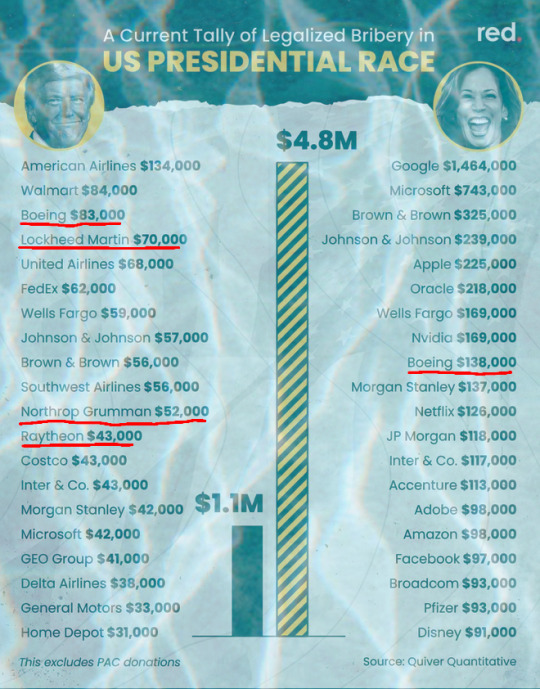
i saw this dumbass graph people were being anti voter with so i've underlined all the companies who manufacture weapons for ur convenience and maybe you can fucking think for a second about why having lockheed martin and raytheon as your top donators rather than fuckin idk microsoft or apple is even a slight bit different and maybe even just slightly worse. just slightly.
77 notes
·
View notes
Text
everyone has super cool headcanons for evil X's name because calling him Evil X/EX is not only Boring but also confusing what is the diffrence in pronunciation of X and Ex aren't both kinda just 'kkkkks' deflating sounds?
And people get so creative with it! Doing fancy word play, one of my favorites being a play on the word noise as xisuma's is the word music the creativity is endless and I have the uttermost respect to these guys
But my head cannon, my head cannon? Excel.
Like the Microsoft program I have a love/hate relationship with.
Like the graph/table/spreadsheet maker
I have yet to try and make anything cool with this head cannon but I want people to know it exists.
(also I think the fact that it means to do well would be some sort of twisted irony and I really really want to write something with them as siblings because people always don't get it how I like it and as an oldest sibling I just-) *gets grabbed by hook and dragged of stage as my nonsensical but passionate rant fades into the background and I claw at the floor boards as curtain close)
#scrambled rambles#hermitcraft#hermitblr#xisumavoid#evil xisuma#xisuma#Does anyone else have cool Ex name head cannons???#And if you do want to hear the sibling relations rant just let me know and then I won't ever stop talking about it.
195 notes
·
View notes